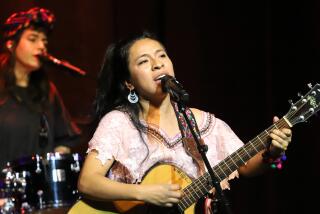Brazilian Beat, With How-To : Katia Moraes and her versatile five-piece band liven up Mission San Juan Capistrano.
- Share via
As the sun’s last rays left the courtyard at the old Mission San Juan Capistrano on Saturday, Brazilian singer Katia Moraes performed a lively number in Portuguese with her band Sambaguru. Then she asked the crowd of picnickers, dancers and rambunctious children: “Is it hot out there?”
Well, not exactly. Cool ocean breezes had begun to steal the day’s warmth. But there were fair amounts of perspiration visible on those grinding away on the dance floor and, for the rest of us, the mood was warm though the air was cool.
Still, the overwhelming response from the crowd was, “Yes!”
So much of Brazilian music, especially as it is played in Southern California, is based on spectacle with dancers and costumes and musicians parading around with exotic instruments. Without the help of those frills, the Rio de Janeiro-born Moraes, appearing as part of the Mission’s “Music Under the Stars” series, created her own spectacle, packing a modest dance floor with undulating bodies and coaxing the assembled to join her in the carnival atmosphere.
Moraes is both cheerleader and educator, urging the crowd to dance this way or that, explaining the different forms her music takes and the regions from which it originated. “Dance like this!” she commanded the crowd. “Now we kiss,” she suggested before one romantic number.
Moraes and her five-piece ensemble aren’t just another samba band. The singer introduced baiao, afoxe and carnaval styles and encouraged particular types of dancing for each.
She dispensed with Antonio Carlos Jobim’s bossa nova anthem “Girl From Ipanema” early in the evening, then concentrated on original material, much of it written by Moraes and keyboardist Bill Brendle. Brendle’s electric keyboard gave the group a bigger presence than its five pieces as he mimicked the sounds of flute or horns with his synthesizer.
Moraes, singing almost entirely in Portuguese, used her pleasant, mid-range voice to good theatrical effect. She was in constant motion, and even when not vocalizing, she cajoled the audience to follow her movements.
While demonstrating a sensual set of moves, she cried, “Like this! Like flirting!” Another time, she ordered dancers to “use your butt a lot!”
The music was cleanly performed and given a fair amount of authenticity with a wide range of instruments. On one parade number, Brendle switched to accordion. On another, he played a tiny electric guitar--a plugged-in version of the Brazilian instrument known as a cavaquinho. Percussionist Kevin Ricard supplied beats from atabaque, bombo and other drums. Even Moraes played the double cow bell agogo during one up-tempo number.
Mario Costa’s “Mae Africa” exemplified the spirit of the evening, with its lively marimba-styled keyboards and percussive accents. Bassist Hussain Jiffry kept each piece pinned to its rhythmic and harmonic form, freeing Ricard and drummer Tony Shogren to explore counterbeats and percussive asides.
But it is Moraes (who opened the Hollywood Bowl’s “Brazil Nights” celebration Sunday), her enthusiasm and apparent love of her native music that separates Sambaguru from most of the bands playing Brazilian music in Southern California.
Nor could there be a better place for such a performance: the bandstand sheltered by a pair of still-blooming jacaranda trees, the audience seated around the courtyard’s central fountain, enjoying picnics at tables and on the grass, and the venerable walls of the mission framing the entire scene.
Moraes and company are scheduled to return to the mission for the last show of the summer music series, on Sept. 26.
More to Read
Sign up for The Wild
We’ll help you find the best places to hike, bike and run, as well as the perfect silent spots for meditation and yoga.
You may occasionally receive promotional content from the Los Angeles Times.






